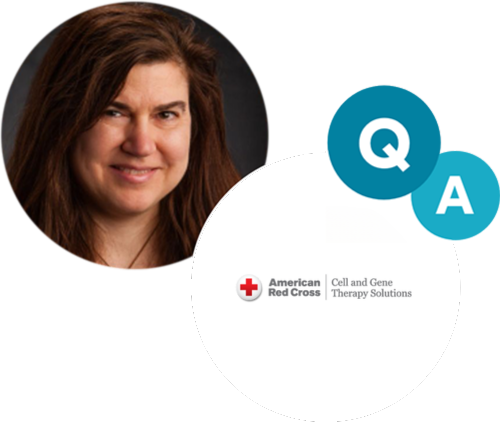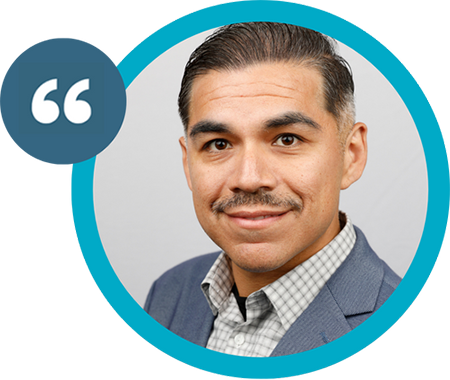

I have been with the American Red Cross for 17 years, starting in donor recruitment and operations before moving into product management within biomedical services five years ago. That experience gave me a deep understanding of donor-derived materials and how they support patient care. Stepping into biotherapies was an exciting opportunity to build on that foundation in a rapidly evolving field.
What keeps me engaged is the ability to support the advancement of therapies in a meaningful way. Currently, I lead product strategy for American Red Cross Cell and Gene Therapy Solutions, focusing on positioning us to meet the expanding needs of the industry. It's been an incredible experience seeing how our allogeneic products and patient leukapheresis collections contribute to research and the development of new treatments. This work is shaping the future of medicine.
The American Red Cross has been involved in biotherapies for over a decade, leveraging our expertise in donor management, collections and our nationwide network to support advancements in the field. Our work in this space aligns with our broader mission of alleviating human suffering and making a lasting impact on patient care.
From the start, our goal has been to do more than provide collections. We've developed an end-to-end program that evolves alongside our partners, offering customized solutions that support them from early research through commercialization. In addition to collections, we offer cell processing, cryopreservation, and storage, all of which help streamline operations and maintain product integrity. When it's time to scale, our national collection network ensures our partners have access to the cellular source material needed to bring these therapies to patients.

The cell and gene therapy landscape has evolved rapidly in recent years, opening up new possibilities for treating a range of diseases. Breakthrough therapies like Casgevy and Lyfgenia for sickle cell disease highlight how gene editing tools like CRISPR are transforming treatment approaches. Research has expanded beyond rare diseases to include areas such as oncology, neurological disorders and autoimmune conditions. At the same time, advancements in manufacturing, including automation, have helped improve efficiency, although challenges related to accessibility and cost remain.
Looking ahead, the industry will continue working toward making these therapies more available to patients. Innovations in manufacturing, such as having manufacturing sites strategically located, decentralized, across the U.S., and close to treatment centers, could help reduce costs and improve access. Advances in gene editing will further enhance safety and effectiveness, and regulatory frameworks will likely evolve to keep pace with scientific advancements. With continued collaboration across research institutions, health care providers and industry leaders, cell and gene therapy is well on its way to becoming a cornerstone of modern medicine.
Developers and suppliers of starting material should work together on short-term and long-term collection needs. Open communication about donor availability, product specifications and future collection goals helps create a stronger, more sustainable donor engagement strategy.
As demand for donor-derived materials continues to grow, managing donor availability remains a shared priority. Donor quality is another key factor. Standardizing collections and processing helps reduce variability and improve consistency. Donor sustainability is also becoming more important, with an increasing need for repeat donors and recallable donor pools to support late-stage development and commercialization.
Developers are also prioritizing donor diversity, recognizing that a broader donor pool is essential to supporting therapeutic outcomes. This is especially important as more cell-based therapies target diverse patient populations.
As the industry evolves, continued collaboration between therapy developers and suppliers of cellular source material will shape donor engagement strategies. Working together to improve donor retention, ensure donor sustainability and meet the needs of expanding therapies will remain key areas of focus.

The expansion of allogeneic therapies is shifting the balance, but autologous and allogeneic approaches will continue to coexist, each serving distinct roles in the future of cell and gene therapy.
Autologous cell and gene therapies remain essential for personalized medicine, particularly in oncology and rare diseases where patient-specific treatments are required. The challenges with these autologous approaches have always been scalability, logistics and cost. While efforts to streamline these processes are ongoing, there remains a need for efficient, scalable and reliable national single-source collection networks that minimize variability and ensure timely access to patient-derived starting material.
Allogeneic therapies, on the other hand, offer the potential for broader scalability and accessibility. The ability to develop off-the-shelf therapies provides advantages in manufacturing efficiency, supply chain logistics and cost-effectiveness. As these therapies advance, there will likely be a greater focus on optimizing donor selection, improving long-term donor recallability, and refining collection processes to ensure consistency and quality at scale.
Rather than one approach replacing the other, the future will likely see both autologous and allogeneic therapies evolving to meet different clinical and commercial needs. Ensuring robust infrastructure and coordination across the field will be key to supporting both models and expanding access to these therapies for patients.
The American Red Cross provides a unique combination of scale, standardization and expertise to support cell therapy developers from research through commercialization. With a nationwide network of apheresis collection sites, we provide broad geographic patient access for leukapheresis collections and reliable donor availability for cellular source material. Our ability to recall donors and maintain dedicated donor pools supports the need for consistent starting material, which is especially critical for late-stage development and commercial manufacturing.
One of our key strengths is our commitment to standardization. We operate under a single Quality Management System (QMS), and one set of national procedures, and use standardized collection protocols across our sites, reducing variability and improving consistency. This level of uniformity is critical as developers work to scale their therapies while maintaining reproducibility.
In addition to donor-based collections, we also support patient leukapheresis cell therapy collections through our nationwide network of community-based collection sites and health care facilities. Our extensive footprint increases patient access, helping developers coordinate collections for patient-specific therapies. Collaborating with clinical sites and ensuring consistent collection procedures is vital for both early-stage and commercial therapies.
These capabilities were developed in response to industry challenges such as donor availability, collection variability and the complexities of scaling from research to commercial supply. As the field evolves, we continue to expand our offerings, including processing, cryopreservation and storage, to support the growing demand for high-quality collection services across allogeneic and autologous therapies.

We continually monitor industry trends, regulatory changes, and gather direct feedback from our cell and gene therapy partners to ensure we are evolving to meet the needs of emerging therapies. This could mean expanding our collection capacity, increasing access to different cell types, or refining our processes to support more advanced manufacturing requirements.
Collaboration plays a crucial role in how we make these decisions. We work closely with biotech companies, researchers and industry leaders to understand pain points in cell sourcing and collection logistics. If we see a growing need, we explore how our nationwide collection network, expertise in donor management and ability to standardize collections can address that gap.
The American Red Cross also takes a data-driven approach. By analyzing collection trends, donor availability, and shifts in therapeutic needs, we can strategically expand our capabilities where they will have the greatest impact. As the field evolves, we remain committed to adapting and growing so we can continue supporting the next generation of therapies.
Quality is at the core of everything we do, particularly when providing cellular source material for cell and gene therapies. We maintain consistency across our nationwide collection network through standardized processes, strict adherence to protocols approved by our in-house institutional review board, oversight from qualified MDs, a centralized QMS, and strict adherence to regulatory and industry guidelines. Our collections are performed by highly trained Red Cross employees, with rigorous donor screening and testing to ensure product integrity. The Red Cross prioritizes donor and patient safety through rigorous protocols, including health screenings to determine eligibility, infection control measures and adherence to FDA guidelines. At the same time, we are always looking for ways to evolve and meet the needs of emerging therapies.
In the short term, the American Red Cross is focused on expanding capacity, increasing access to healthy donors who meet rigorous eligibility criteria, enhancing testing capabilities, and refining processes to improve efficiency and consistency. In the long term, we are exploring how technology and automation can help streamline collections, processing and data tracking while strengthening partnerships that support the next generation of therapies.
One exciting project is the rollout of benchtop flow cytometry devices across all donor centers by the end of the year for our allogeneic starting material. These devices will provide real-time insights into the makeup of collected products, allowing for a better understanding of cell composition through leukopak product characterization. This level of data will help in confirming the identity, purity and function of the cellular products. This promotes the appreciation of cellular functions and responses to cellular manipulation, which in turn will support clinical researchers toward the advancement of critical medical innovations.
Beyond that, the American Red Cross will continue to collaborate with biotech companies, research institutions, and industry leaders to ensure our services evolve alongside the field. Whether it is improving donor matching, optimizing cell processing or supporting clinical trials, we remain committed to providing high-quality starting material that advances therapy development and, ultimately, benefits patients.

Cell and gene therapy is evolving rapidly, and the work we do today will help shape the future of medicine. Whether you are in product development, research or operations, staying adaptable is key. The landscape is constantly shifting, from regulatory changes to emerging technologies, and the ability to adjust while keeping the focus on bringing therapies to patients will always be crucial.
For those in leadership roles, one of the best things you can do is surround yourself with people who challenge you and offer diverse perspectives. The best ideas often come from collaboration, and in a field as complex as this, no one has all the answers.
Success in this space is not just about innovation, it's about execution. Bringing therapies to more patients takes coordination, standardization, and the ability to solve challenges quickly. Organizations that can balance strategic thinking with flexibility will be the ones driving the industry forward.
At the end of the day, we are all working toward the same goal. It is an exciting time to be in this field, and I am grateful to contribute to its progress.
For further information on CellSource sponsorship please see AABB's Media Kit page or email businessdevelopment@aabb.org to discuss upcoming availability.

Keep abreast of what's happening in the field of biotherapies with CellSource - AABB's monthly update on the latest biotherapies news.